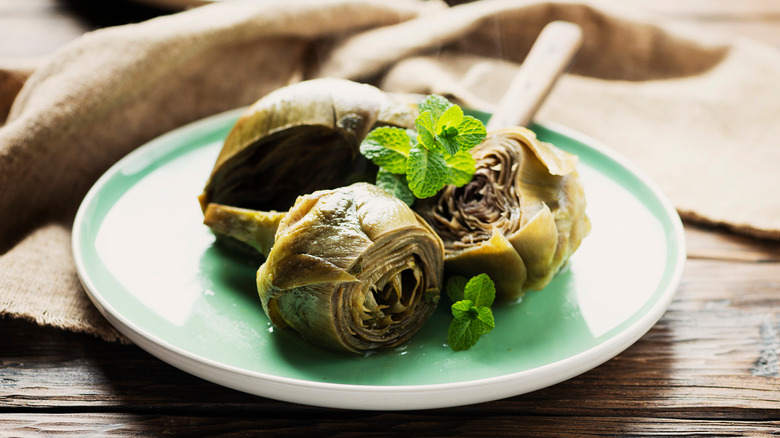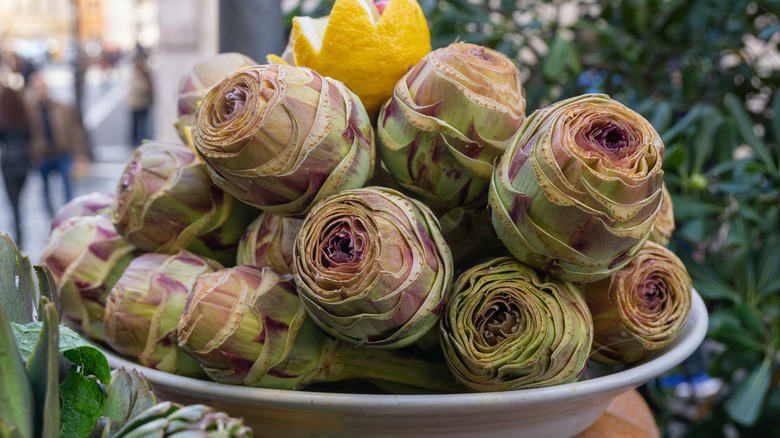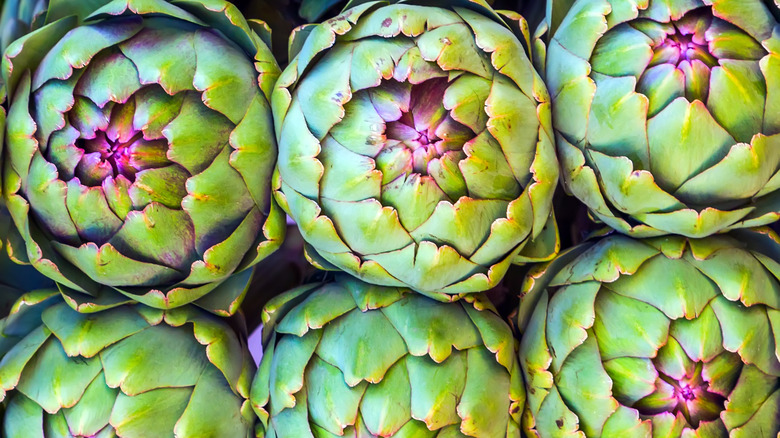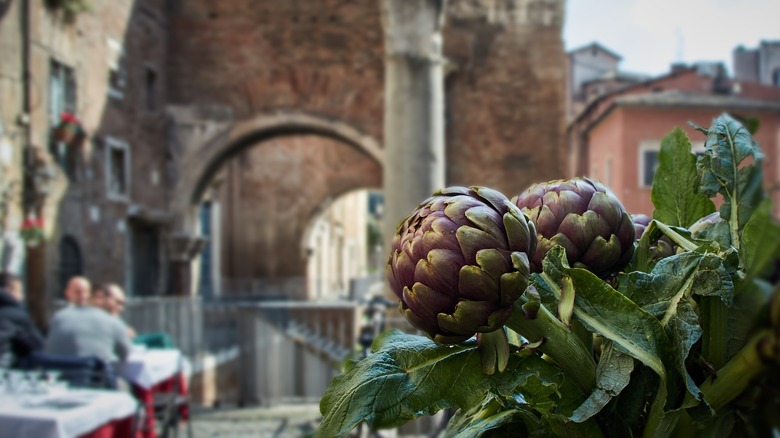Carciofi Alla Romana: The Roman Artichoke Dish Featuring A Unique Herb
When in Rome, eat as the Romans do. Such a command is fairly easy to obey when the staple dishes of the Italian city include carbonara, cacio e pepe, and pizza al taglio, among other cheesy, saucy delights. And none of that is even touching upon Roman desserts. In a city with ample gelaterias, pastry shops, and cappuccino-ready cafes, savory dishes are occasionally an afterthought.
Yet Rome is a city of many culinary delights, and its fresh produce is surely not to be overlooked. One vegetable in particular packs a lot of power, at least in the springtime. When in season, carciofi alla Romana — in English, that's Roman artichokes — is an underrated Italian dish. You'll find it all throughout its namesake city, where the best dinners begin with an artichoke appetizer.
Once you try the Eternal City's trademark artichoke dish, you'll be thinking about it for, well, eternity. For that claim to fame, it has one herb in particular to thank.
Carciofi alla Romana are made with olive oil, wine, and a variation of calamint
Simplicity is a hallmark of Italian cooking. Dishes from the beloved European country tend to use few — but high-quality — ingredients, and Roman artichokes are no exception. They are essentially artichokes braised until tender. They're contained in a sauce of olive oil, wine, and herbs, per Serious Eats.
While a seemingly uncomplicated recipe, the herbs are somewhat challenging to come by. According to Serious Eats, the main herb in Roman artichoke recipes is mentuccia, also known as nepitella. Whichever name you know it by, the herb is a kind of calamint.
Outside of Italy, recipes tend to equate mentuccia to mint, but that's not quite right. Orchard Nursery defines it as a woodsy herb akin to a mixture of mint, yes, but also oregano and basil. It works well in meat recipes, pasta, or vegetable dishes in which oregano would typically be used instead.
Stocking up on nepitella requires research, creativity and an airtight container
If only we could stop by Rome's Campo de' Fiori market to stock up on artichokes and nepitella for ourselves. Per The Heirloom Seed Store, nepitella, or mentuccia, hails from central and southern Italy. It's popular in Rome and throughout Italy's Tuscany region.
Outside of Europe, however, nepitella is somewhat difficult to come by. You can find it in specialty grocery stores or online, like on the Milk Street website or Amazon. If you'd rather devise a do-it-yourself version of the herb, Serious Eats suggests combining fresh oregano with mint for a similar effect.
Like most herbs, a little bit packs a lot of punch. Use it sparingly on dishes, at least at first. You can utilize nepitella leaves fresh or dry (via The Heirloom Seed Store). Once you've taken a pinch, store the remaining leaves in a compact container. Orchard Nursery suggests leaving them in a cool, dry setting.
Making Roman artichokes from home is a labor of love
Once you've acquired your herbs, it's time to get to cooking. Making any artichoke, not to mention the Roman version, may seem like a complex process. The vegetable requires a lot of care. You'll have to prepare your artichokes by trimming and cleaning their sharp stems before setting them in the pot. Although this may seem daunting and time-consuming, it's fairly easy to get the hang of.
For the sake of Roman-style artichokes, you'll also want to give special attention to trimming the skin from your artichoke's heart and stem (via Martha Stewart). Once your artichokes are ready, cut them in half before arranging them in a pot. Pour over your wine, herb, and oil mixture.
As for cooking time and temperature, Serious Eats recommends setting your stove to medium-high heat until your artichokes come to a simmer. Then, it's best to lower the heat and let your artichokes cook while covered. In roughly half an hour, they should be tender ... and your mouth should be watering.
Other artichoke variations are worth a taste — herbs optional
While carciofi alla Romana is certainly a delicious take on artichokes, they're not the end-all-be-all for the vegetable. You can also make crispy artichokes with anchovy aioli for a distinctive and unique take on the produce or spinach-artichoke dip for your next game night.
To continue paying homage to Italy, however, try your hand at making Italian-style stuffed artichokes. Per The Food Network, this iteration requires filling artichoke leaves with Pecorino cheese and breadcrumbs before baking.
Yet if you'd rather stay hyper-local, hone in on Rome once again. It's easy to make the city's other artichoke dish. Beyond carciofi alla Romana, the Eternal City boasts carciofi alla giudia: Jewish-style artichokes. These artichokes are especially popular in Rome's Jewish quarter, which offers no shortage of Roman-Jewish cuisine.
Unlike Rome's tender version, however, carciofi alla giudia are fried in olive oil, though they're similarly simple to make. Per Bon Appetit, they consist of only lemon, olive oil, and, of course, artichokes. No nepitella in sight.




